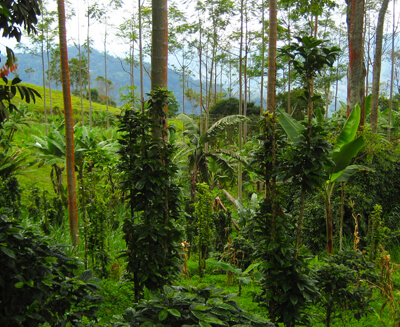Study Shows Growing Coffee and Cacao in Shade Helps Birds
 |
| Shade-grown Coffee in Colombia by Brian Smith |
(August 16, 2012) While natural forests provide the best habitat for tropical birds, a new study from the University of Utah found that wooded “shade” plantations – called agroforests — that produce coffee and chocolate with some native forest trees left standing, provide four times greater bird diversity than open farmland.
The findings also suggest that as open farmland replaces forests and agroforests, the reduced number of bird species and the shifts in the populations of various types of birds may reduce the benefits that birds provide to people, such as eating insect pests, spreading seeds, and pollinating crops.
“We found that agroforests are far better overall for bird biodiversity in the tropics than open farms,” says study author Dr. Cagan H. Sekercioglu (pronounced Cha-awn Shay-care-gee-oh-loo), an ornithologist, who is also an assistant professor of biology at the University of Utah.
The study looked at 6,093 tropical bird species, including migratory birds, whose top three habitat choices (out of 14 possible habitats) included forests, farms, or both, with the latter described as agroforest birds. It found that 4,574 bird species included forest but not farms in their top three habitats, only 303 species that included farms but not forests in their top three habitat choices, but 1,216 agroforest species that include both forests and farms among their top three habitats.
“For the last twelve years, American Bird Conservancy has been encouraging and supporting South American conservation partners to engage more farmers and ranchers in agroforestry or “silvipasture” practices. This study demonstrates scientifically the benefits of this type of farming to birds, and provides an incentive for environmentally conscious consumers to choose certified bird-friendly, shade-grown coffee or chocolate,” said Dr. George Fenwick, President of American Bird Conservancy, the only organization exclusively conserving birds throughout the Americas.
ABC and its International Partners have produced and planted more than 950,000 native trees and coffee bushes in agroforestry and silvipasture systems in Nicaragua, Colombia, and Peru to provide enhanced habitat for migratory and resident birds.
“This study joins a growing body of evidence affirming that ABC's efforts to restore trees to agricultural landscapes in previously forested areas will benefit birds” said Dr. Daniel Lebbin, Conservation Biologist in ABC's International Division.
The Smithsonian Institution, the Rainforest Alliance, and the Rainforest Action Network all certify shade coffee. Other crops grown in shade include cardamom, and yerba mate, a tree whose leaves are steeped in hot water to make a caffeinated beverage popular in South America.
The findings of this study suggest that conversion of forest to farmland may reduce “ecosystem services” that birds provide to people.
“As you go [from forests] to more and more open agriculture, you lose some bird groups that provide important ecosystem services like insect control, seed dispersal and pollination, while you get higher numbers of granivores [seed and grain eaters] that actually can be crop pests,” Sekercioglu says. Specifically:
- Insect-eating birds do best in forests – especially those that live near the ground in the understory, the layer of plants below the tree canopy and above the ground cover. But small and medium insect-eating birds, especially migrant and canopy species, do well in agroforests. The number of insect-eating species declines on open farms, where they are most needed to help control pests.
- Fruit-eating birds, especially larger ones, “do best in forest because they have more habitat and more food, and the large ones often are hunted outside forests in agricultural settings. Overall, frugivores – especially smaller ones – do OK in agroforests, but the number of fruit-eating species declines significantly on open farms.” Frugivores help spread the seeds of the fruits they eat.
- Nectar-eating birds help pollinate many plants. They “tend to increase in agroforests compared with forests. A lot of nectar-eating birds obviously like flowers, and many plants flower when there's some light. When you have extensive forest its often pretty shady so not many things are in flower at any given time.” The nectar eaters are less common on open farms.
- Omnivorous birds “tend to do better in agroforests and especially on open farms” than in forests, because the mixed habitat tends to provide a more varied diet.
- Grain- and seed-eating birds are “the only group that significantly increases in open agricultural areas. A lot of the seeds they eat are grass seeds, but also from crops. Some of these seed-eating bird species are major agricultural pests, and that's another reason for encouraging agroforests.”


















































